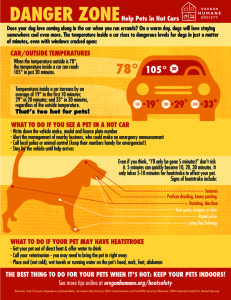HOW TO HELP ANIMALS IN IMMEDIATE DISTRESS
If you see an animal in distress because of the heat, please take immediate steps to help, in addition to calling local police.
Provide the pet with a bowl of cool water; create a shady area where the animal can relax; set up a water sprinkler for the animal; knock on the doors of neighbors to see if anyone has access to the animal’s house. If possible, bring the pet indoors.
If the animal is locked in a car, please see the section below about pets in vehicles.
Hot Weather Safety Advice
Heat and Sun Safety: Quick Tips
- Keep drinking water bowls full of cool, fresh water
- Provide shaded areas where a pet can rest if outdoors
- Use a misting hose to provide a cool area for a pet while outside
- Utilize a kiddie pool for dogs to splash and relax in
- Keep an eye on pets around water—not all pets are natural swimmers
- Exercise or have strenuous playtime in the cool of the morning or at dusk, not during heat of the day
- Do not leave pets unattended outside when it gets hot; bring inside
- Leave your pet at home when you are running errands (see below) – NOT in the car
- Light-colored pets can sunburn—check with your veterinarian before applying sunblock to your pet’s nose
Fleas: Summer is also the worst time of year for fleas. Talk with your vet about the best treatment options for your pet to prevent fleas, ticks and other pests.
Water: Make sure your pet always has access to shade and fresh drinking water, especially when weather turns hot and dry. More below.
Parked Cars and Other Vehicles

The Oregon Humane Society encourages you to leave your pet home and inside when you dash to the store or another errand. The inside of a car heats up very quickly. On an 85 degree day, a car’s interior temperature can climb to 120 degrees in 20 minutes, even with the windows slightly open.
What to do if you see a pet alone in a hot car:
Write down the car’s make, model and license plate number.
If there are businesses nearby, notify their managers or security personnel and ask them to make an announcement to find the car’s owner.
If the owner can’t be found, call the non-emergency number of the local police and/or animal control and wait by the car for them to arrive.
Can you break a car window to save a life?
The public, as well as police, can now break a car’s window to rescue a pet or child in imminent danger without fear of being sued for damages. The new law, which took effect in June of 2017, protects people from criminal and civil liability if they break a car window to save a child or animal who is left alone and appears to be in imminent danger. Breaking a window is a last resort: before a good Samaritan chooses to break a car window, law enforcement must be contacted (call police or 911 in an emergency). Rescuers must stay with the animal until first responders arrive or the owner of the car returns. Be mindful that a dog or cat may feel protective of their space or even run off when faced with a stranger.
Download the full-size OHS Hot Car infographic »
Download a smaller version to print and put on windshields »
Heatstroke and Other Heat Emergencies
Symptoms of heatstroke include: restlessness, excessive thirst, heavy panting, lethargy, lack of appetite, dark tongue or gums, vomiting, lack of coordination or even collapse, and an internal temperature over 104° F.
Contact your veterinarian immediately if you notice these symptoms. Quick action could save your pet’s life.
Help your pet cool down: First, get your pet out of direct heat. Check for signs of shock and take your pet’s temperature if possible. Offer water to drink. Then: use a fan to blow cool air on the pet; place water-soaked towels (or running water) on the pet’s head, neck, feet, chest and abdomen; rub isopropyl alcohol (70%) on a dog’s foot pads for cooling (do not allow dog to ingest). Do not use ice-cold water or ice—use cool water to avoid shock.
Safe cooling and consequences of heatstroke: “During a heat crisis, the goal is always to decrease the animal’s body temperature to 103° F in the first 10-15 minutes. Once 103° F is reached, you must stop the cooling process because the body temperature will continue to decrease and can plummet dangerously low if you continue to cool the dog for too long.
Even if you successfully cool your pet down to 103° F in the first 10-15 minutes, you must take the dog to a veterinarian as soon as possible because consequences of heat stroke will not show up for hours or even days. Potential problems include abnormal heart rhythms, kidney failure, neurological problems and respiratory arrest.” – from the American Red Cross
Highly susceptible pets: Animals with flat faces, like pugs and Persian cats, are more susceptible to heat stroke since they cannot pant as effectively. These pets, along with the elderly, the overweight, and those with heart or lung diseases, should be kept cool in air-conditioned rooms as much as possible. Note that a dog’s or cat’s normal body temperature is between 101 and 102 degrees.
If you see an animal in danger: If you suspect an emergency situation has developed and an animal (not your own) is in immediate danger from the heat, first consult the owner if possible and then contact your local animal control agency or local police department.
Hot Pavement
Pavement, asphalt, metal, and even sand that have been heated by the sun can burn dogs’ paw pads. Remember: if the surface is too hot for your bare hand or foot, it’s too hot for your dog’s feet.
Post-Swim Sensitivity: Pads can be soft and more sensitive after swimming, so take heed if your pup refuses to walk on the pavement after a swim.
Some ways to avoid pad burns:
- Walk your dog early or late in the day, out of the heat
- Walk frequently when it’s cool to build up callus on the pads
- Walk on the grass when hot surfaces are unavoidable
- Moisturize your dog’s pads daily with paw balms or creams
- Lay down a wet towel for your dog to stand on when grassy areas are not available
Signs of burned pads include: limping or refusing to walk, licking or chewing at the feet, pads darker in color, missing part of pad, blisters or redness on the feet.
First aid for burned pads: keep the foot area cool and clean. Immediately flush with cool water and a gentle antibacterial such as betadine. Get the dog to a grassy area or if possible, carry him/her. Keep the dog from licking the wounds. For minor burns, spread the area with antibacterial ointment and cover with a loose bandage.
For serious burns, take the dog to your vet for further treatment. This is important to prevent infection and further damage.
Generally speaking, keep your dogs off of hot surfaces whenever possible.



